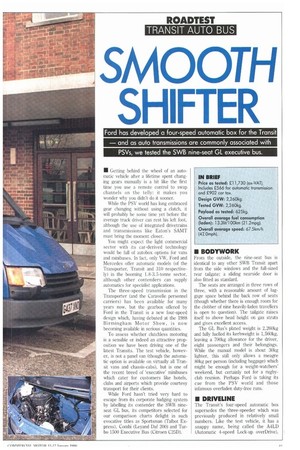SMOOTH SHIFTER
Page 53

If you've noticed an error in this article please click here to report it so we can fix it.
Ford has developed a four-speed automatic box for the Transit -and as auto transmissions are commonly associated with PSVs, we tested the SWB nine-seat GL executive bus.
• Getting behind the wheel of an automatic vehicle after a lifetime spent changing gears manually is a bit like the first time you use a remote control to swap channels on the telly: it makes you wonder why you didn't do it sooner.
While the l'SV world has long embraced gear changing without using a clutch, it will probably be some time yet before the average truck driver can rest his left foot, although the use of integrated drivetrains and transmissions like Eaton's SAMT must bring the moment closer.
You might expect the light commercial sector with its car-derived technology would be full of autobox options for vans and minibuses. In fact, only VW, Ford and Mercedes offer automatic models (of the Transporter, Transit and 310 respectively) in the booming 1.8-3.5-tonne sector, although other contenders can supply automatics for specialist applications.
The three-speed transmission in the Transporter (and the Caravelle personnel carriers) has been available for many years now, but the gearbox offered by Ford in the Transit is a new four-speed design which, having debuted at the 1988 Birmingham Motor Show, is now becoming available in serious quantities.
To assess whether clutchless motoring is a sensible or indeed an attractive proposition we have been driving one of the latest Transits. The test vehicle, however, is not a panel van (though the automatic option is available on virtually all Transit vans and chassis-cabs), but is one of the recent breed of 'executive' minibuses which cater for customers like hotels, clubs and airports which provide courtesy transport for their clients.
While Ford hasn't tried very hard to escape from its corporate badging system by labelling its contender the SWB nineseat GL bus, its competitors selected for our comparison charts delight in such evocative titles as Sportsman (Talbot Express), Combi (Leyand Daf 200) and Turbo 1500 Executive Bus (Citroen C25D).
• BODYWORK
From the outside, the nine-seat bus is identical to any other SWB Transit apart from the side windows and the full-sized rear tailgate; a sliding nearside door is also fitted as standard.
The seats are arranged in three rows of three, with a reasonable amount of luggage space behind the back row of seats (though whether there is enough room for the clobber of nine heavily-laden travellers is open to question). The tailgate raises itself to above head height on gas struts and gives excellent access.
The GL Bus's plated weight is 2,260kg and fully fuelled its kerbweight is 1,560kg, leaving a 700kg allowance for the driver, eight passengers and their belongings. While the manual model is about 30kg lighter, this still only allows a meagre 80kg per person (including baggage) which might be enough for a weight-watchers' weekend, but certainly not for a rugbyclub reunion. Perhaps Ford is taking its cue from the PSV world and those infamous overladen duty-free runs.
• DRIVELINE The Transit's four-speed automatic box supersedes the three-speeder which was previously produced in relatively small numbers. Like the test vehicle, it has a snappy name, being called the A4LD (Automatic 4-speed Lock-up overlirive).
















































































































